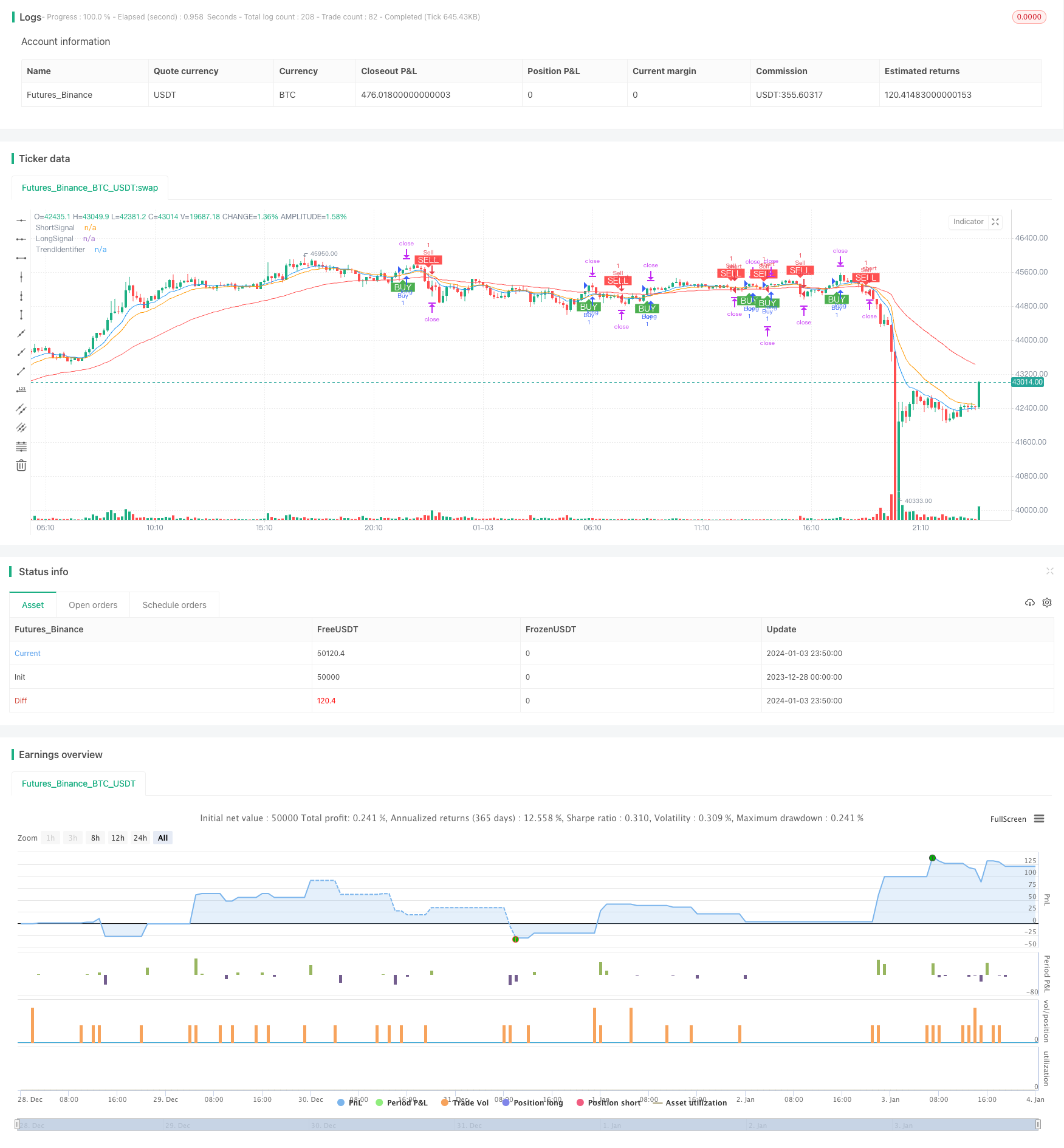Quantitative Trading Strategy Based on EMA Crossover
Author: ChaoZhang, Date: 2024-01-05 14:01:25Tags:

Overview
This strategy is named “Quantitative Trading Strategy Based on EMA Crossover”. It utilizes the crossover principles of 9-day, 15-day and 50-day EMA lines to trade within short timeframes between 1-minute and 5-minute, in order to capture short-term price trends for quick entry and exit.
Strategy Principles
The strategy employs 9-day EMA, 15-day EMA and 50-day EMA. The crossover between 9-day EMA and 15-day EMA generates buy and sell signals. When 9-day EMA crosses above 15-day EMA, a buy signal is generated. When 9-day EMA crosses below 15-day EMA, a sell signal is generated. The 50-day EMA line judges the overall trend direction - buy signals are only generated when price is above 50-day EMA, and sell signals below it.
By utilizing fast EMA crossover and long-term EMA support, the strategy aims to capture short-term price actions while avoiding counter trend operations. The crossover of two fast EMAs ensures timely catching of recent price changes; the long period EMA effectively filters out market noise to prevent loss-making contrarian trades.
Advantages of the Strategy
-
Captures short-term trends: The crossover of two fast EMAs quickly seizes short-term price movements for swift entry and exit.
-
Filters out noise: Long EMA line judges overall direction to avoid ineffective contrarian trades and unnecessary stop loss.
-
Customizable parameters: Users can tweak EMA periods to adapt to different market conditions per their needs.
-
Easy to adopt: Relatively straightforward EMA crossover logic for facile utilization.
Risks of the Strategy
-
Too sensitive: Two fast EMAs may generate excessive false signals.
-
Ignores long-term trends: Long EMA cannot fully filter noise - some contrarian risks remain.
-
Parameter dependency: Optimized parameter reliance on historical data cannot guarantee future viability.
-
Suboptimal stop loss: Fixed stop loss difficult to calibrate - likely too loose or too tight.
Optimization Directions
-
Add Stochastics indicator to filter signals and employ KDJ overbought-oversold levels to augment EMA crossover signals.
-
Build in adaptive stop loss mechanism based on market volatility levels for intelligent adjustment of stop loss points.
-
Establish parameter optimization module via genetic algorithms for continual iteration towards optimum parameter combinations.
-
Integrate machine learning models to judge trend and signal accuracy, improving strategy resilience.
Conclusion
The strategy generates trade signals through crossover of two fast EMAs, and a long EMA line to determine overall direction, aiming to seize short-term price movements. Such short-term strategies are easy to use but have flaws e.g. excessive false signals, ignoring long-term trends. Solutions include adding auxiliary indicators, adaptive mechanisms and parameter optimization to improve real-life stability.
/*backtest
start: 2023-12-28 00:00:00
end: 2024-01-04 00:00:00
period: 10m
basePeriod: 1m
exchanges: [{"eid":"Futures_Binance","currency":"BTC_USDT"}]
*/
//@version=4
strategy("EMA Crossover Strategy", overlay=true)
// Define the EMAs
shortEma = ema(close, 9)
mediumEma = ema(close, 15)
longEma = ema(close, 50)
// Plot EMAs
plot(shortEma, title="ShortSignal", color=color.blue)
plot(mediumEma, title="LongSignal", color=color.orange)
plot(longEma, title="TrendIdentifier", color=color.red)
// Define the crossover conditions
buyCondition = crossover(shortEma, mediumEma) and close > longEma
sellCondition = crossunder(shortEma, mediumEma) and close < longEma
// Plot labels for crossovers with black text color
plotshape(series=buyCondition, title="Buy Signal", location=location.belowbar, color=color.green, style=shape.labelup, text="BUY", textcolor=color.white)
plotshape(series=sellCondition, title="Sell Signal", location=location.abovebar, color=color.red, style=shape.labeldown, text="SELL", textcolor=color.white)
// Define the strategy conditions
if (buyCondition)
strategy.entry("Buy", strategy.long)
strategy.exit("Take Profit", "Buy")
if (sellCondition)
strategy.entry("Sell", strategy.short)
strategy.exit("Take Profit", "Sell")
// Run the strategy
strategy.exit("TP/SL", profit=1, loss=0.5)
- Chandelier Exit Strategy
- The Momentum Driven Triple Confirmation Trend Following Strategy
- Fisher Turnaround EMA Multi-Take Profit and Multi-Stop Strategy
- Moving Average System Trading Strategy
- MACD Crossover Trading Strategy
- Visual Comparison between Strategy and Buy & Hold Returns
- Reversal Tracking Strategy with Double Mechanisms
- Golden Ratio Moving Average Trading Strategy
- Price Drop Buy Strategy in Downtrend with Stop Loss
- Reversal Momentum Compound Strategy
- Ichimoku Cloud Quantitative Trading Strategy
- Trend Following Moving Average Trading Strategy
- Trend Following Momentum Breakout Strategy
- Breakout and Intelligent Bollinger Bands Price Channel Strategy
- Simple Trend Following Strategy
- Long Breakthrough Strategy Based on K-Line Construction
- Momentum Oscillating Moving Average Trading Strategy Based on Buffered Bollinger Bands
- Adaptive Backtest Date Range Selection Strategy Based on Double MA
- Multi-Timeframe Moving Average Crossover Optimization Strategy
- Breakthrough Tracking Strategy